Mystery of Holocaust escape girls solved after 84 years
 Getty Images
Getty ImagesThe picture of three Jewish girls fleeing Nazi Germany became an iconic image appearing in museums, exhibitions and publications. It was taken at London's Liverpool Street station, but for more than 80 years the girls' identities were a mystery. Until now.
Inge doesn't remember the picture being taken and for decades did not even know of its existence.
The five-year-old had fled her home in Breslau, Germany, now Wroclaw in Poland, with her seven-year-old sister Ruth.
Their mother and younger sister had stayed behind and were murdered at Auschwitz.
It was not until she was a pensioner that Inge even realised she and Ruth, who died in 2015, had been forever immortalised as an icon of the Holocaust and Kindertransport, the mass evacuation of Jewish children from Nazi Germany in 1939.
 Adamecz family
Adamecz familyShe came across the picture in Never Again, a book by historian Martin Gilbert.
"That was a big surprise," said Inge, whose maiden name was Adamecz.
"He just put in the book 'Three little girls', so I wrote to him and said we are very much alive. People say I look like Shirley Temple. Why am I smiling?
"Look at Ruth, she was very affected.
"I don't know who that third girl is with the doll. I've never known who she is."

The girl with the doll was in fact 10-year-old Hanna Cohn, who arrived on the same train as the girls with her twin brother Hans, later called Gerald, from Halle in Germany.
Hans' trouser leg can be just made out in the original glass plate of the picture.
Like Inge and Ruth, Hanna had no memory of the photo being taken, although she did remember the journey and the doll.

She died in 2018 but spoke of her experiences in an interview with the University of London.
"I remember going through Holland and kind ladies giving us sticky buns and lemonade," she said.
"We got to Liverpool Street station on this train from Harwich and I'm such a conformist the seats were upholstered, they weren't wooden seats and I was very worried we might be in the first class by mistake.
"I was also worried we were going to Liverpool Street, as I thought we were going to London and Liverpool was somewhere else.
"However, we arrived in this great big hall. I was clutching a doll which I named Evelyn."
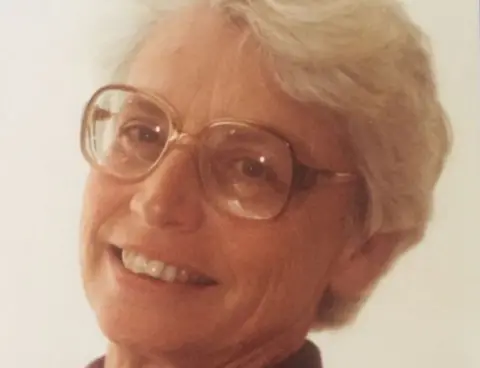 Singer family
Singer familyHanna first became aware of the photograph when her brother spotted it in an exhibition at Camden Library in London to mark the 50th anniversary of the Kindertransport.
Her twin daughters Debbie and Helen Singer said she was always very curious about the two other girls.
"When we saw the photo and she's sitting there with her plait and her doll she would say, 'I wonder who the other two girls are?'," Debbie said.
Then in January, more than 80 years after the photo was taken, her daughters discovered the truth after coming across a BBC audio series.
Our story, The Girls: A Holocaust Safe House, told the forgotten story of a North-East hostel where Inge, whose married name is Hamilton, and Ruth had spent part of the war.
"It was Holocaust Memorial Day and a friend of mine sent me a link to the news item on the BBC website," Helen said, adding: "I thought, 'Why is she sending me this link' and I scrolled down and I saw the picture with mum and the names of the two other girls, Ruth and Inge.
"We were so excited. I texted Debbie and I said, 'We've found the girls'."
Then in April, Inge finally met Hanna's daughters at the Imperial War Museum in London, where the photograph has been on display for more than 20 years, to learn more about both their families and what happened after it was taken.
"Inge is this special person in our lives," Debbie said, adding: "I think mum would be really proud of us.
"She always talked about those two little girls and the fact we've found them would be really important to her."
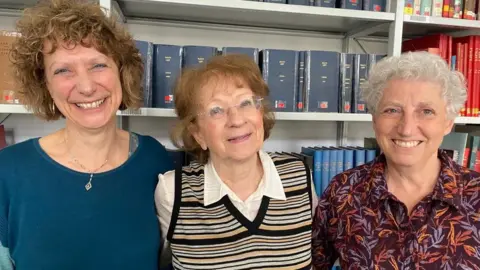
But what of the photographer?
We know from records held by the Getty Images Hulton Archives that his name was Stephenson and he worked for the Topical Press Agency, which employed more than 1,000 photographers supplying images for a huge newspaper industry.
The day book, where the photographer's jobs were recorded, survives for 5 July 1939 and marked clearly is "Three little children waiting at Liverpool Street Station", with the photographer's name Stephenson in the margin.
We can't know for sure, but it's possible he was a Scot called John F Stevenson (both forms of spelling were used in the records) who found fame for co-writing the song Dear Old Glasgow Toon.
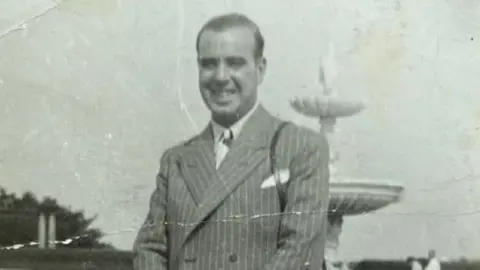 Stevenson family
Stevenson familyIn the 1930s, The Topical Press Agency held an address for him in Glasgow.
With help from the National Records of Scotland, through addresses on birth and death certificates, we tracked down his family.
His journalist grandson Gordon Stevenson was fascinated by the story of his grandfather's career as a freelance press photographer in the late 30s.
"We knew that he'd taken photographs all his life and we've got lots of his pictures," Gordon said, adding: "We knew it was a huge part of his life.
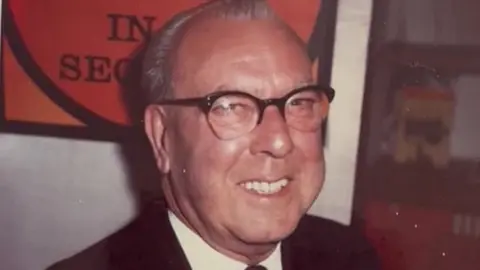 Stevenson family
Stevenson family"But that was always in his later years, so this revelation of a quite eclectic career in the late 30s was a complete shock, but a fabulous one.
"We didn't know anything about his photographic career south of the border.
"So, to discover this kind of history we knew nothing about was a real revelation and we're still struggling to comprehend the possibility this was him, but it's just absolutely lovely."
The photograph appeared in national newspaper The News Chronicle the day after it was taken, but was then used only occasionally until the digital age, when it appeared more and more often in newspapers and exhibitions.
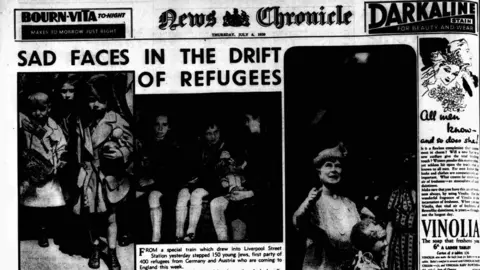
And during a visit by Debbie and Helen Singer, Getty Archives updated its records so the caption accompanying the photo gives the names of all three girls.
"I feel quite tearful, because our mother's name and where she came from are now attached to this photograph along with Inge and Ruth and they're not just nameless children," Debbie said.
Helen agreed, adding: "These were not just 'three little girls', they were people who had names and lives that mattered.
"They deserved to be named and we think our mother would have been happy about this."
Inge, now aged 89 and living in south London, has waited more than 80 years to learn the name of the kind girl who shared her doll with her.
She now knows much more about the photograph that has followed her around.
"This photograph has been a long way," she said, adding: "It just seems to attract people."
Additional reporting by Duncan Leatherdale.

Follow BBC North East & Cumbria on Twitter, Facebook and Instagram. Send your story ideas to [email protected]
